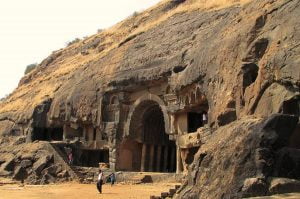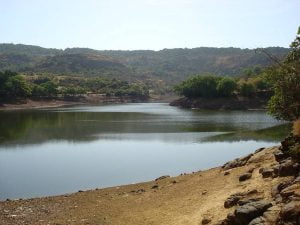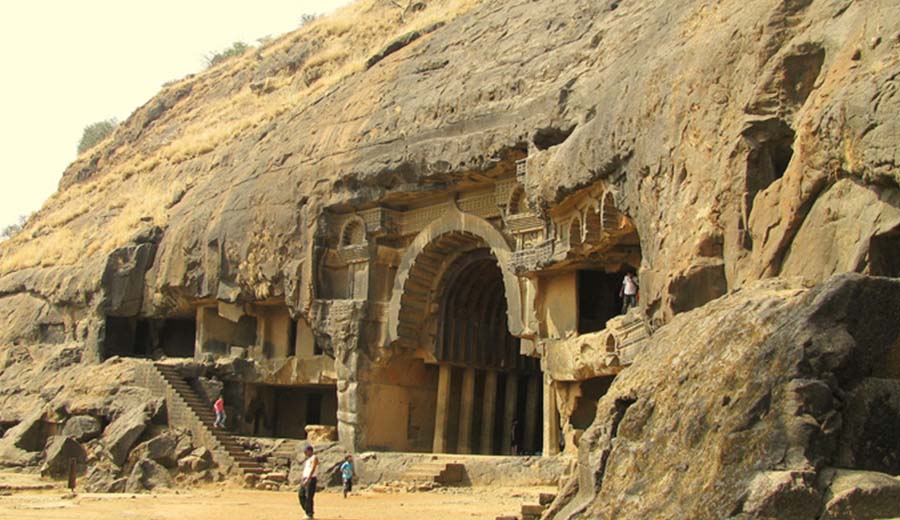Karla Caves
All you need to know about Karla Caves
Around 114 km from Mumbai or about 40 km from Pune, in the small town earlier known as Lenauli, and currently known as Lonavala, the Western Ghats houses one of the most impressive rock-cut caves complexes, consisting of 16 caves, in India. Known as the Karla caves, often locally referred to as Karli or Karle caves, is one of the oldest and one of the most beautiful cave complexes, that India has to offer to its tourists. The cave complex has both Hindu and Buddhist ethnic connections, featuring, the Buddhist viharas and Chaityagrhs, and a Hindu temple of Goddess Ekveera also referred to in some places in India as goddess Renuka.
Historical facts Karla Caves
Carbon dating and rock inscriptions found in the cave complex estimate that the complex was developed over a considerable period of time, from the second century BC to around the 10th century A.D. with the oldest prayer hall (also known as Chaityagrha) dating back to 120 BC. The Karla caves, set a magnificent example of the ancient craftsmanship finesse, with the entire complex barring the first cave ornately carved, from top to down.
Though less popular, and thus relatively less crowded, the cave complex is no less magnificent than the famous Ajanta and Ellora caves, in terms of architectural excellence, and at times surpasses them. For example, the eighth cave of the Karla cave complex, better known as the great Chaityagrh, features the largest rock-cut Buddhist prayer hall in India measuring around 148 feet long and 46 feet high, with intricate decorations of both human forms and animals.
Architectural Facts of Karla Caves
It is often argued, that in terms of architecture the Karla caves, follow a chronology of perfection beginning with the Kondivite Caves, continuing with the Bhaja Caves, the Ajanta Caves, the caves at Pitalkhora, the Kondana Caves, the Cave number 9 at Ajanta, Cave number 18 at Nasik Caves, the Bedse Caves, to the “final perfection” of the Great Chaityagrh at Karla Caves. Although the architecture follows the pattern which is usual for architecture and a similar period, the standout in the case of the Karla caves is its quintessential vastness. The earlier caves were attributed to a more ancient branch of Buddhism, where the Buddha imagery (in form of statues) was not found. Instead, it is replaced by a stupa.
Beautiful Sculptures and Lighting
The most magnificent Chaityagrha, has beautiful sculptures, often imitating woodwork, in the intricacies and ornamentation on both sides of the central doorway and inside. The carvings mostly describe human forms, lions and elephants, with Mithuna, or women and men in pairs forming the dominating art form in the human carvings. It is also believed that the elephant carvings had original ivory tusks and the walls were covered with murals, however, no evidence, concrete to this respect has been found.
Another interesting feature of the Karla caves, and the ways the lighting source has been carved in. Huge windows have been carved on the rock, in a way so that the hard sunlight is muffled to a proper tone, to soothe the exquisiteness of the sculptures and ornate carvings.
Attraction around Karla Caves
Bhaja Caves:

Bhaja Caves are a group of rock-cut Buddhist caves located near the Karla Caves in the Maharashtra state of India. The caves are known for their unique rock-cut architecture and well-preserved paintings and sculptures. The caves date back to the 2nd century BCE and are considered to be some of the earliest examples of rock-cut architecture in India. Visitors can admire the intricate carvings and sculptures of Buddhist deities, as well as the stunning views of the surrounding hills and valleys.
Lohagad Fort:
Lohagad Fort is a historic hill fort located near the Karla Caves in Maharashtra. The fort dates back to the 17th century and was used by Maratha forces during the Anglo-Maratha Wars. Visitors can explore the fortifications, including its gateways and bastions, as well as take in the panoramic views of the surrounding hills and valleys. The fort is also a popular destination for trekkers and offers challenging trekking routes.
Bhushi Dam:
Bhushi Dam is a popular picnic spot located near the Karla Caves in Maharashtra. Surrounded by lush greenery and beautiful waterfalls, the dam is a popular destination for families and visitors seeking a peaceful escape from the city. Visitors can enjoy boating, fishing, and picnicking in the tranquil surroundings. The dam is also a popular destination for photographers and nature lovers.
Shirdi:
Shirdi is a famous pilgrimage site located approximately 120 km from the Karla Caves in Maharashtra. The town is known as the home of the popular saint Shirdi Sai Baba and attracts millions of visitors each year. Visitors can explore the various temples and shrines dedicated to the saint, as well as participate in the various religious ceremonies and rituals that take place throughout the year.

Lonavala is a popular hill station located near the Karla Caves in Maharashtra. The hill station offers scenic views, and adventure activities, and is a popular getaway destination. Visitors can enjoy trekking, rock climbing, and other adventure activities, as well as take in the stunning views of the surrounding hills and valleys. Lonavala is also known for its scenic waterfalls, lush forests, and rolling hills, making it a popular destination for nature lovers.
Karla Caves Activity
The Karla Caves are an ancient rock-cut Buddhist monastery located in the Maharashtra state of India. Visiting the caves is a popular activity for tourists and history enthusiasts. Some of the popular activities to do at the Karla Caves include:
- Cave Exploration: Visitors can explore the caves and admire the intricate rock-cut architecture, sculptures, and inscriptions that date back to the 2nd century BCE.
- Photography: The caves offer a unique opportunity for photographers to capture the ancient structures and natural beauty of the surrounding hills.
- Meditation: The peaceful and serene atmosphere of the caves makes them an ideal location for meditation and introspection.
- Trekking: The caves are located in the hills and offer challenging trekking routes for adventure seekers.
- History and Culture: Visitors interested in history and culture can learn about the origins and significance of the Karla Caves, as well as the ancient Buddhist culture of India.
- Religious Pilgrimage: For those who are religious, the Karla Caves are considered to be a sacred site and offer a unique opportunity to connect with the spiritual heritage of ancient India.
How to reach
Karla Caves are located in the Maharashtra state of India and can be reached by various modes of transportation. Here are the details on how to reach the Karla Caves:
By Air: The nearest airport to the Karla Caves is the Mumbai International Airport, which is located approximately 120 km away. From the airport, visitors can hire a taxi or take a bus to reach the caves.
By Train: The nearest railway station to the Karla Caves is the Lonavala Railway Station, which is located approximately 10 km away. Visitors can take a taxi or a local bus from the station to reach the caves.
By Bus: The Karla Caves are well connected by road and are accessible by local buses from nearby cities and towns.
By Car: Visitors can also reach the Karla Caves by hiring a taxi or driving their own vehicle. The caves are located on the Mumbai-Pune Expressway and are well-connected by road.
Note: It is advisable to check the local transport options and road conditions before planning your trip to the Karla Caves.
Best time to visit
The best time to visit the Karla Caves in Maharashtra, India, depends on various factors such as climate, monsoon season, and peak tourist season. Here are a few things to consider:
- Climate: The best time to visit the Karla Caves is from October to March when the weather is pleasant and ideal for outdoor activities. During this time, the temperature is cool and visitors can avoid the scorching heat of the summer months.
- Monsoon Season: The Karla Caves are located in an area that receives heavy rainfall during the monsoon season from June to September. The roads to the caves may be affected by landslides and flash floods, making it difficult to reach the caves during this time.
- Peak Tourist Season: The Karla Caves are a popular tourist destination and can get crowded during the peak tourist season from October to March. Visitors may find it difficult to get accommodation and may have to deal with long lines at the caves.
In conclusion, the best time to visit the Karla Caves is from October to March when the weather is pleasant and ideal for outdoor activities. Visitors should avoid visiting the caves during the monsoon season and the peak tourist season to avoid crowds and travel difficulties.



